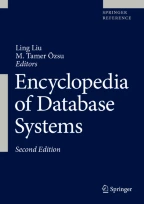Synonyms
Moving object trajectories; Spatio-temporal representation
Definition
A spatio-temporal trajectory can be straightforwardly defined as a function from the temporal I ⊆ ℝ domain to the geographical space ℝ2, i.e., the 2-dimensional plane. From an application point of view, a trajectory is the recording of an object’s motion, i.e., the recording of the positions of an object at specific timestamps.
Generally speaking, spatio-temporal trajectories can be classified into two major categories, according to the nature of the underlying spatial object: (i) objects without area represented as moving points, and (ii) objects with area, represented as moving regions; in this case the region extent may also change with time. Among the above two categories, the former has attracted the main part of the research interest, since the majority of real-world applications involving spatio-temporal trajectories consider objects represented as points, e.g., fleet management systems monitoring...
Access this chapter
Tax calculation will be finalised at checkout
Purchases are for personal use only
Recommended Reading
Almeida VT, Guting RH. Indexing the trajectories of moving objects in networks. GeoInformatica. 2005;9(1):33–60.
Arumugam S, Jermaine C. Closest-point-of-approach join for moving object histories. In: Proceedings of the 22nd International Conference on Data Engineering; 2006. p. 86.
Bakalov P, Hadjieleftheriou M, Keogh E, Tsotras V. Efficient trajectory joins using symbolic representations. In: Proceedings of the 6th International Conference on Mobile Data Management; 2005. p. 86–93.
Brakatsoulas S, Pfoser D, Salas R, Wenk C. On map-matching vehicle tracking data. In: Proceedings of the 31st International Conference on Very Large Data Bases; 2005. p. 853–64.
Chen L, Özsu MT, Oria V. Robust and fast similarity search for moving object trajectories. In: Proceedings of the ACM SIGMOD International Conference on Management of Data; 2005. p. 491–502.
Chomicki J, Revesz P. A geometric framework for specifying spatiotemporal objects. In: Proceedings of the 6th International Workshop Temporal Representation and Reasoning; 1999. p. 41–6.
Erwig M, Güting RH, Schneider M, Varzigiannis M. Spatio-temporal data types: an approach to modeling and querying moving objects in databases. GeoInformatica. 1999;3(3):265–91.
Forlizzi L, Güting Nardelli E, Schneider M. A data model and data structures for moving objects databases. In: Proceedings of the ACM SIGMOD International Conference on Management of Data; 2000. p. 319–30.
Frentzos E, Gratsias K, Pelekis N, Theodoridis Y. Algorithms for nearest neighbor search on moving object trajectories. GeoInformatica. 2007;11(2):159–93.
Frentzos E, Gratsias K, Theodoridis Y. Index-based most similar trajectory search. In: Proceedings of the 23rd International Conference on Data Engineering; 2007. p. 816–25.
Guting RH, Bohlen MH, Erwig M, Jensen CS, Lorentzos NA, Schneider M, Vazirgiannis M. A foundation for representing and querying moving objects. ACM Trans Database Syst. 2000;25(1):1–42.
Keogh E. Exact indexing of dynamic time warping. In: Proceedings of the 28th International Conference on Very Large Data Bases; 2002. p. 406–17.
Meratnia N, By R. Spatiotemporal compression techniques for moving point objects. In: Advances in Database Technology, Proceedings of the 9th International Conference on Extending Database Technology; 2004. p. 765–82.
Pfoser D, Jensen CS, Theodoridis Y. Novel approaches to the indexing of moving object trajectories. In: Proceedings of the 26th International Conference on Very Large Data Bases; 2000. p. 395–406.
Tao Y, Kollios G, Considine J, Li F, Papadias D. Spatio-temporal aggregation using sketches. In: Proceedings of the 20th International Conference on Data Engineering; 2004. p. 214–26.
Vlachos M, Kollios G, Gunopulos D. Discovering similar multidimensional trajectories. In: Proceedings of the 18th International Conference on Data Engineering; 2002. p. 673–84.
Author information
Authors and Affiliations
Corresponding authors
Editor information
Editors and Affiliations
Section Editor information
Rights and permissions
Copyright information
© 2018 Springer Science+Business Media, LLC, part of Springer Nature
About this entry
Cite this entry
Frentzos, E., Theodoridis, Y., Papadopoulos, A.N. (2018). Spatiotemporal Trajectories. In: Liu, L., Özsu, M.T. (eds) Encyclopedia of Database Systems. Springer, New York, NY. https://doi.org/10.1007/978-1-4614-8265-9_364
Download citation
DOI: https://doi.org/10.1007/978-1-4614-8265-9_364
Published:
Publisher Name: Springer, New York, NY
Print ISBN: 978-1-4614-8266-6
Online ISBN: 978-1-4614-8265-9
eBook Packages: Computer ScienceReference Module Computer Science and Engineering
